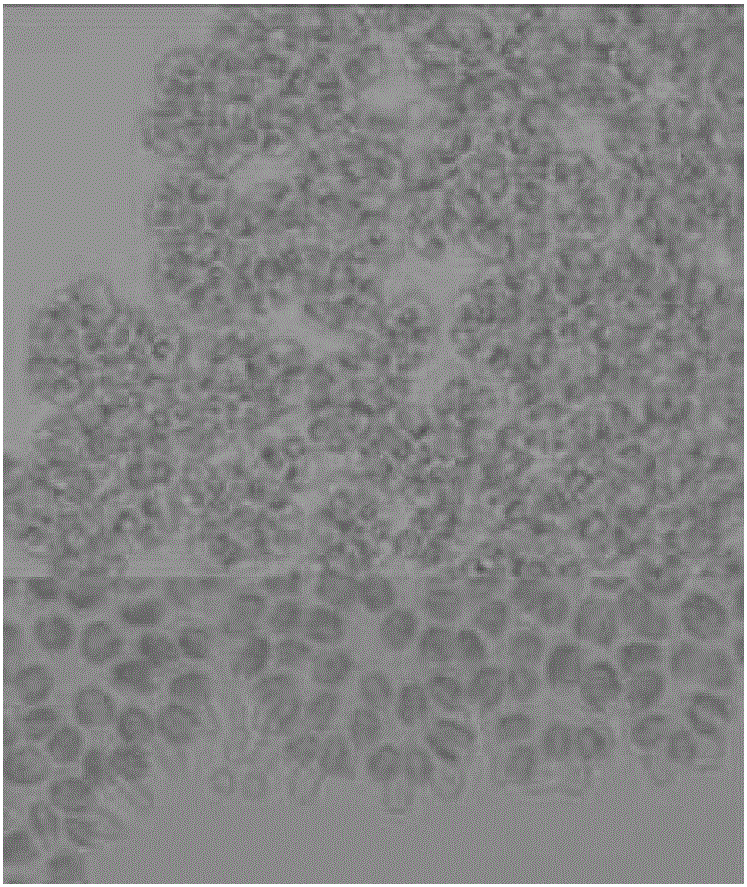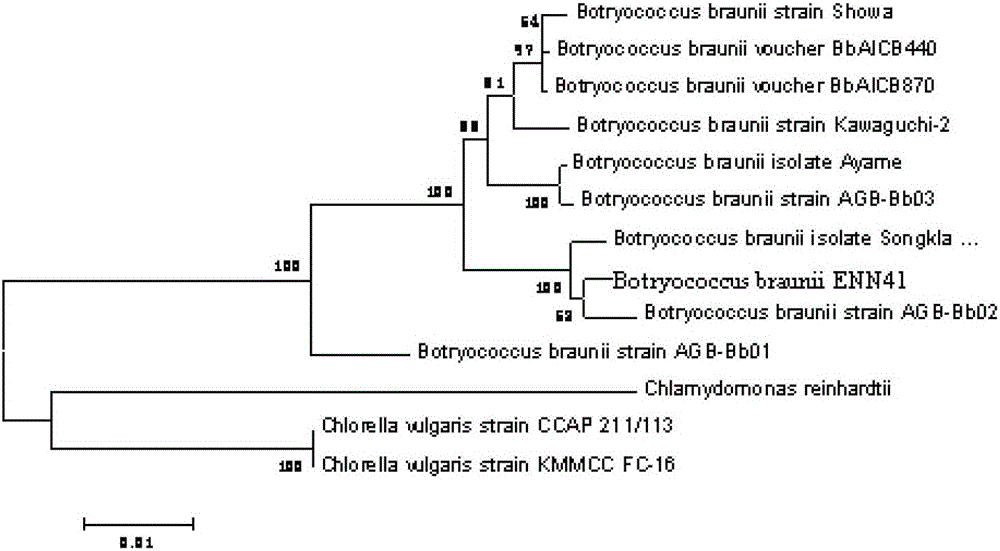Brown Botrytis and Its Application
A technology of botrytis braziliana and algae strains, applied in the field of microbial engineering, can solve the problems of slow growth of botrytis, low total hydrocarbon content, and limited application, and achieve the effects of high hydrocarbon content, fast growth speed, and high biomass
- Summary
- Abstract
- Description
- Claims
- Application Information
AI Technical Summary
Problems solved by technology
Method used
Image
Examples
Embodiment 1
[0039] Example 1 Separation, purification and screening of algae strains
[0040] Method 1: Add 1 / 3 volume of BG11 medium (see Table 1 for the formula) to the pond water sample retrieved from Hainan area, culture for about one month, draw 20-100μL of water sample and drop it on the glass slide, use 40 times Or observe with a microscope at 100 times, move the Botryococcus algae cells into the middle of the field of view, use a glass capillary with an inner diameter of 0.9 to 1.1 mm to burn it with an alcohol lamp outside flame for 1 to 5 seconds and then quickly stretch it. The diameter of the capillary is pulled to about 100 μm. Directly suck the algae cells under the microscope field and inoculate them in a 48-well culture plate containing BG11 medium (see Table 1 for the formula) at 25°C and a light intensity of 50 μmol / m 2 ·Cultivate for about 3 weeks under the condition of s, observe under microscope, select wells with only single algae strains, pave the plate or streak the pl...
Embodiment 2
[0047] Example 2 Classification and identification
[0048] (1) Shape identification
[0049] Observed under a microscope, ENN41 algae cells are elliptical or wedge-shaped and appear as clusters of colonies; cell size: 6μm~8μm in length, 5μm~7μm in width, and aggregate population over 50μm; cell color is black-green or yellow-brown; cell pack It is covered in a translucent group of glues with irregular branches or leaves; two spore-like spores are often formed during cell division, and the group is often broken into small groups. The strain was preliminarily identified as Botryococcus braunii.
[0050] Microscopic examination pictures such as figure 2 Shown.
[0051] (2) Molecular identification:
[0052] 18S sequence amplification adopts eukaryotic 18S amplification universal primers (primer synthesis is synthesized by Shanghai Shenggong Biological Engineering Company).
[0053] Primer 15’CCTGGTTGATCCTGCCAG3’
[0054] Primer 25’TTGATCCTTCTGCAGGTTCA3’
[0055] PCR amplification obtains ...
Embodiment 3
[0072] Example 3 Growth in a 3cm column reactor
[0073] The ENN41 algae strain in the logarithmic growth phase was inoculated into the prepared BG11 medium (see Table 1 for the formula) to make the cell density reach OD 750 Is 0.3. The reactor used for the culture is a column reactor with an inner diameter of 30 mm and a length of 600 mm. The light intensity gradually increases according to the cell state and density, and the light intensity is controlled at 50~500μmol / m during the culture process 2 ·S. 24 hours of light, during the culture period, the pH value of the culture medium is adjusted between 7-9 by passing 1.5-2% carbon dioxide and air mixed gas into the culture solution. The temperature is regulated in the range of 20-35℃. During the cultivation process, samples are taken regularly to determine the dry weight, and the results are shown in Figure 5 . The ENN41 algae strain was cultured in the general BG11 medium for 16 days, and the dry weight reached 8.40g / L on t...
PUM
| Property | Measurement | Unit |
|---|---|---|
| clearance rate | aaaaa | aaaaa |
Abstract
Description
Claims
Application Information
 Login to View More
Login to View More - R&D
- Intellectual Property
- Life Sciences
- Materials
- Tech Scout
- Unparalleled Data Quality
- Higher Quality Content
- 60% Fewer Hallucinations
Browse by: Latest US Patents, China's latest patents, Technical Efficacy Thesaurus, Application Domain, Technology Topic, Popular Technical Reports.
© 2025 PatSnap. All rights reserved.Legal|Privacy policy|Modern Slavery Act Transparency Statement|Sitemap|About US| Contact US: help@patsnap.com



